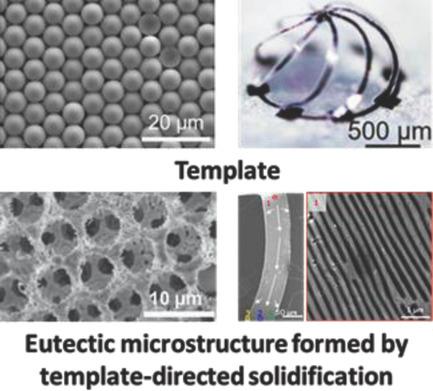当前位置:
X-MOL 学术
›
Adv. Opt. Mater.
›
论文详情
Our official English website, www.x-mol.net, welcomes your feedback! (Note: you will need to create a separate account there.)
Template‐Directed Solidification of Eutectic Optical Materials
Advanced Optical Materials ( IF 9 ) Pub Date : 2018-03-30 , DOI: 10.1002/adom.201800071 Ashish A. Kulkarni 1 , Julia Kohanek 1 , Kaitlin I. Tyler 1 , Erik Hanson 2 , Dong-Uk Kim 2 , Katsuyo Thornton 2 , Paul V. Braun 1
Advanced Optical Materials ( IF 9 ) Pub Date : 2018-03-30 , DOI: 10.1002/adom.201800071 Ashish A. Kulkarni 1 , Julia Kohanek 1 , Kaitlin I. Tyler 1 , Erik Hanson 2 , Dong-Uk Kim 2 , Katsuyo Thornton 2 , Paul V. Braun 1
Affiliation

|
Mesostructured materials can exhibit enhanced light–matter interactions, which can become particularly strong when the characteristic dimensions of the structure are similar to or smaller than the wavelength of light. For controlling visible to near‐infrared wavelengths, the small characteristic dimensions of the required structures usually demand fabrication by sophisticated lithographic techniques. However, these fabrication methods are restricted to producing 2D and a limited range of 3D structures. When a large volume of structured material is required, the primary approach is to use self‐assembly, and the literature includes many examples of mesostructured optical materials formed via self‐assembly. However, self‐organized materials almost always contain structural imperfections which limit their performance. Emerging work, however, is showing that by performing self‐assembly within a guiding template, the defect density in self‐assembled structures can be reduced. Particularly interesting is the possibility that utilizing a template can result in the formation of mesostructures not present in either the template or the native self‐organizing material. In this review, particular emphasis is placed on emerging results showing the effect of mesoscale templates on the microstructure of solidifying eutectic materials, with a specific focus on how template‐directed solidification may be a powerful approach for fabricating optically active structures, including optical metamaterials.
中文翻译:

共晶光学材料的模板定向固化
介观结构的材料可以表现出增强的光-物质相互作用,当结构的特征尺寸等于或小于光的波长时,这种相互作用会变得特别强烈。为了控制可见到近红外波长,所需结构的小特征尺寸通常需要通过复杂的光刻技术来制造。但是,这些制造方法仅限于产生2D和有限范围的3D结构。当需要大量结构化材料时,主要方法是使用自组装,并且文献中包括许多通过自组装形成的介观光学材料的示例。但是,自组织材料几乎总是包含结构缺陷,从而限制了它们的性能。但是,新兴的工作 表明通过在引导模板内执行自组装,可以降低自组装结构中的缺陷密度。利用模板可能导致模板或天然自组织材料中不存在的介观结构形成的可能性特别令人感兴趣。在这篇综述中,特别强调新兴的结果,这些结果显示了中尺度模板对凝固共晶材料微观结构的影响,并特别关注模板定向凝固如何可能是制造光学活性结构(包括光学超材料)的有效方法。利用模板可能导致模板或天然自组织材料中不存在的介观结构形成的可能性特别令人感兴趣。在这篇综述中,特别强调新兴的结果,这些结果显示了中尺度模板对凝固共晶材料微观结构的影响,并特别关注模板定向凝固如何可能是制造光学活性结构(包括光学超材料)的有效方法。利用模板可能导致模板或天然自组织材料中不存在的介观结构形成的可能性特别令人感兴趣。在这篇综述中,特别强调新兴结果,这些结果显示了中尺度模板对凝固共晶材料微观结构的影响,特别着重于模板定向凝固如何可能是制造光学活性结构(包括光学超材料)的有效方法。
更新日期:2018-03-30
中文翻译:

共晶光学材料的模板定向固化
介观结构的材料可以表现出增强的光-物质相互作用,当结构的特征尺寸等于或小于光的波长时,这种相互作用会变得特别强烈。为了控制可见到近红外波长,所需结构的小特征尺寸通常需要通过复杂的光刻技术来制造。但是,这些制造方法仅限于产生2D和有限范围的3D结构。当需要大量结构化材料时,主要方法是使用自组装,并且文献中包括许多通过自组装形成的介观光学材料的示例。但是,自组织材料几乎总是包含结构缺陷,从而限制了它们的性能。但是,新兴的工作 表明通过在引导模板内执行自组装,可以降低自组装结构中的缺陷密度。利用模板可能导致模板或天然自组织材料中不存在的介观结构形成的可能性特别令人感兴趣。在这篇综述中,特别强调新兴的结果,这些结果显示了中尺度模板对凝固共晶材料微观结构的影响,并特别关注模板定向凝固如何可能是制造光学活性结构(包括光学超材料)的有效方法。利用模板可能导致模板或天然自组织材料中不存在的介观结构形成的可能性特别令人感兴趣。在这篇综述中,特别强调新兴的结果,这些结果显示了中尺度模板对凝固共晶材料微观结构的影响,并特别关注模板定向凝固如何可能是制造光学活性结构(包括光学超材料)的有效方法。利用模板可能导致模板或天然自组织材料中不存在的介观结构形成的可能性特别令人感兴趣。在这篇综述中,特别强调新兴结果,这些结果显示了中尺度模板对凝固共晶材料微观结构的影响,特别着重于模板定向凝固如何可能是制造光学活性结构(包括光学超材料)的有效方法。



























 京公网安备 11010802027423号
京公网安备 11010802027423号